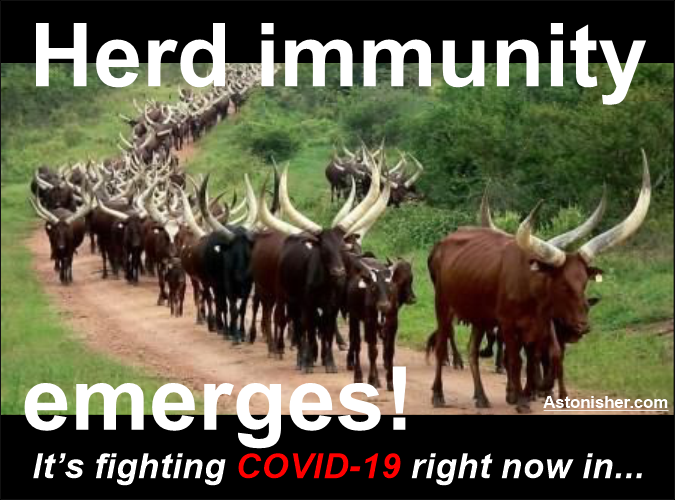‘Herd Immunity Emerges!’ by Bruce Brown

Click here for more of Bruce Brown’s columns!
HERE ARE the two ironically different sides of the coronavirus coin today.
All over the world right now, in poorer places that were badly hammered by the coronavirus onslaught this spring, we are beginning to see the emergence of “herd immunity” to COVID-19.
Meanwhile, in more affluent areas where most people wore masks and COVID-19 transmission was suppressed, there is no increased herd immunity to COVID-19 at all. People in these upscale areas are as vulnerable to the disease as they ever were.
This was predicted in March by Azra Ghani, the lead epidemiologist on the new model of the outbreak from Imperial College London. “Suppressing transmission means that we won’t build up herd immunity,” Ghani said, adding that the trade-off of mask success is “that we are driving it [herd immunity] down to such a low level that we have to keep those control [measures] in place.”
BUT FIRST the good news! Global coronavirus cases continue to soar, with India reporting a new single-day record as Germany, France and South Korea recorded their worst daily infection rates in months, even as new infections and deaths in the U.S. fell.
In addition, the coronavirus infection rate earlier this year is now believed to be much higher than previously thought. Even in the United States, with good health care and record keeping systems, the CDC now reports that it under estimated the number of infections last spring by 90 percent or more.
“For most sites [in the U.S.], it is likely that greater than 10 times more… infections occurred than the number of reported Covid-19 cases,” according to the Centers for Disease Control. In New York, the CDC estimates suggest that 642,000 people were infected by April 1 but at that point only 53,803 cases were officially reported. That means the number of infections could be at least 12 times higher than reported, the CDC said.
As one might expect, the shortfall in COVID-19 infection estimates has been even more pronounced in the poorer parts of the world. For instance, Agence France-Presse reports that in India more than a quarter of New Delhi’s 20 million residents may have caught the novel coronavirus without showing symptoms, according to a study released Thursday. According to Agence France-Presse:
Extrapolated, the antibody study on 15,000 residents means 5.8 million people in the bustling capital could have caught the virus — more than 37 times the official tally of 156,139 infections.
OK, BUT exactly why is it good news that 5.8 million people have caught COVID-19 in New Delhi, 5.6 million more than previously thought?
Because it means that many hard hit areas — such as New York in the U.S., Bergamo in Italy, and New Delhi in India — have already purchased their herd immunity ticket and had it punched!
You see, in order to achieve herd immunity, you don’t need all the population to be immune, just a sufficient portion — often thought to be 65 percent of the total, although some scientists now believe herd immunity can be attained with approximately 40 percent of the total population immune, or even below 20 percent.
Bingo! In New York City, the New York Times reports that tests reveal coronavirus antibodies in 68 percent of residents of poor, hard hit areas of the city, compared to 13 percent antibodies for more affluent neighborhoods.
And the proof is in the pudding. New York City had no COVID-19 related deaths today, August 25, and according to the State it has tested below one percent new infections for the last 18 days in a row.
In Italy, the pattern has been the same. In older populations like the Italian COVID-19 epicenter in Bergamo, a town where one in four residents are pensioners, 60 percent of the population had antibodies by early June, according to the London Telegraph, and the hospital emergency rooms that were Bedlam last spring are largely silent now.
Meanwhile, in India, we find in this Times of London story that:
a study of people in Pune published on Monday showed that 51.5 per cent of residents in some areas of the city had Covid-19 antibodies. Last month, surveys showed that half the residents of a slum in Mumbai had had the virus and nearly a quarter of the 20 million people in New Delhi, the capital, had antibodies.
“If we are getting figures of one in four or over 50 per cent in urban areas — and all surveys show the same trend — India is moving towards herd immunity, but we need more data,” said Dr. Jayaprakash Muliyil, an epidemiologist.

FINALLY, I give you the biggest herd immunity news of all. It’s a zinger that “upends notions of herd immunity” as the Washington Post put it in a calm, dispassionate headline today.
This one comes out of the depths of the Amazon, where the jungle and nominal poverty of the population are huge. This spring, the Amazonian city of Manaus, Brazil, became a global symbol of the devastation the coronavirus disease can wreak in the developing world.
But then the virus receded and Maraus has since returned to complete normalacy, without ever imposing a lockdown or even social distancing! Scientists are now speculating herd immunity to COVID-19 has ALREADY BEEN ACHIEVED in Manaus, as well as New York, Bergamo, New Delhi and hundreds of other hard-hit cities that have stabilized this summer.
Neither Manaus nor neighboring Guyaquille ever got above 33% of the population testing positive for COVID-19 antibodies, yet they both have apparently achieved herd immunity.
“Manaus is an interesting case, indeed,” said Jarbas Barbosa da Silva, assistant director of the Pan American Health Organization. “The hypothesis – and this is just a hypothesis – is that the peak we had in Manaus was very strong, and there was such widespread community transmission that it may have produced some kind of collective immunity.”
EARLIER THIS summer, there was considerable concern because it appeared that coronavirus antibodies (and hence it was assumed, immunity) faded quickly after a person recovered from the disease.
However, it has subsequently become apparent that antibodies comprise only a part of a body’s immunological response to COVID-19. T-cells and other defenders (so-called “immunological dark matter”) are now believed to play a significant role in many cases. So antibody test results are really only a partial measure of immunity; a person’s immunity may be significantly stronger than their antibodies reveal.
And now the whole age-old array of natural human biological and behavioral immunity weapons (AKA herd immunity) have begun to assert themselves against COVID-19 — everywhere, that is, except where political leaders have ordered the broad, general populace to wear masks and suppress part of humanity’s natural pandemic survival response.
So ironically, the poor are beginning to climb out of the water on the far shore of the coronavirus pandemic while the rich cling to their face mask life preserves, too terrified to swim for it!
Stay tuned for the next exciting episode of… An Irony Every Instant! or Humanity – What A Species!
— Bruce Brown
Editor, Coronavirus Vaccine & Herd Immunity Digest
 |  |  |  |
